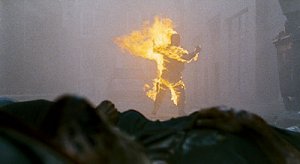Saturday, October 24th, 2009
•
Horrorthon Posts / Horrorthon Reviews


(2007) **
This movie diminished in my estimation with each passing scene, so that my prediction of the rating I would give slipped from four-star to three-star to two-star over the course of its (brief) running length. It’s too bad, because writer/director Juan Carlos Fresnadillo and the other filmmakers clearly wanted to follow respectfully in the footsteps of Danny Boyle’s vastly superior 28 Days Later (2002), and the ambitious seriousness with which they took on that task is worth celebrating and rewarding. Unfortunately, despite the tremendous care taken to extend the elements of the first movie without altering or diminishing them, the project is fundamentally ill-conceived and the resulting movie is a hopeless muddle.
The basic problem isn’t really anyone’s fault: the original story is too balanced, too complete; there’s no legitimate hook with which to build a sequel. 28 Days Later mimicked the structure of conventional zombie movies, but invented a clever “hard-sci-fi” alternative to the zombie mechanism itself: rather than walking undead, the ubiquitous ghouls were living people infected by a fictitious virus that generates the same zombie-like behavior (e.g. incoherence; attempting to eat everybody). The “RAGE” virus (created in a laboratory and accidentally released) spreads through the exchange of contaminated bodily fluids like a conventional infection, but does it quickly, so that anyone bitten or cut (or bled upon) by an infected person becomes an insane, blood-vomiting cannibal in a matter of seconds. Speed was the key concept behind most of the scenes in 28 Days Later; rather than silently lumbering around like George A. Romero zombies, Boyle’s “infected” sprint towards their victims en masse, screaming like banshees, to terrifying effect. (That’s my biggest problem with Weeks, by the way: with the exception of an excellent opening sequence, the movie just isn’t that scary.)
As any devotee of conventional zombie movies knows, zombies = end of the world; there’s no way to tell a zombie story without discussing the apocalypse, since there’s really no way to beat them (as octopunk put it, “the zombies get the upper hand and never lose it”). But the victims of the “RAGE” virus are different, and, as a result, Boyle’s movie has a (relatively) happy ending, in which the British military successfully contains the virus to the U. K., and the clear implication is that the world’s governments will help rebuild and repopulate Britain. The movie ends with what appears to be conclusive evidence of a competently-run aftermath, and a corresponding sense of finality. This is the big problem for the writers of Weeks: how to re-kindle a fire that’s basically been extinguished. What they came up with—this movie’s central idea—seemed vaguely promising as the movie began, but, as I said, it’s really just a card-house that collapses in slow motion, with the final cards dropping just as the movie ends.
The new story centers around a single nuclear family of survivors, who have been separated during the aftermath of the original “RAGE” crisis. Parents Robert Carlyle and Catherine McCormack are hiding in a remote farmhouse with a small group of survivors; their children (Imogen Poots and Mackintosh Muggleton) (those are the actual names) have been removed from the country according to plotting that I couldn’t quite follow, and are brought back to London much later as part of an American-led NATO military initiative to repopulate the city. In the movie’s opening sequence (and its only genuinely frightening scene) the parents’ fortified farmhouse is penetrated and attacked by “the infected,” and Carlyle (displaying the sort of horror-movie cowardice for which characters are always exquisitely punished) leaves his wife behind to perish and runs for safety. Seven months later (see the title) the children are reunited with their father (who keeps his shameful secret about abandoning their mother) in a Baghdad-style “green zone” within London that’s the foundation of NATO’s repopulation efforts.
But Mom is still alive, hiding in the family’s original London town house, and is discovered by the children when they escape the military perimeter and return there to gather their belongings. It takes the military a spectacularly long time to figure out where the kids have gone and to retrieve them, despite the fact that rooftop snipers with powerful telescopic scopes actually witnessed their escape. (Already, as I’m sure I’m making clear, the story is beginning to come apart; there’s just no way to justify any of this behavior.) The mother is medically unique: an Army doctor (the excellent Rose Byrne, who played the spacecraft pilot in Danny Boyle’s sublime 2007 sci-fi thriller Sunshine) discovers that she’s been bitten—she’s carrying the “RAGE” virus—but she’s somehow immune to its effects. This means that she (and, according to some tenuous medical logic, her children) are the key to discovering a cure for the virus itself, which would seem like a far more urgent goal if the spread of the infection hadn’t been successfully contained and neutralized in the first movie.
There are some intriguing procedural sequences surrounding the above events, including some reasonably diverting portrayals of extreme military operations against the unfamiliar backdrop of a modern Western city, but the card-house has already begun to fall apart. The filmmakers proceed to completely lose control of the story, so that the immediate, requisite escalation of fiascos (the virus begins to spread; the father and then the mother are lost; the security of the green zone is compromised; the military discipline breaks down; the power goes out; chaos reigns) is the result of every single character behaving in the stupidest possible fashion and of every surveillance and monitoring system in the city being ignored or overlooked. The intriguing family drama (the kids discover their father’s shameful secret) is tossed overboard immediately; new characters are introduced and summarily dispatched; the NATO forces appear to go insane and do everything the filmmakers can think of to make the situation worse.
None of this is remotely interesting or frightening, and the across-the-board failure of the movie to generate any suspense, fear or interest stands in marked contrast to the original movie, which is a masterpiece of horror in comparison. It’s fairly obvious that the disquieting, profound way that the Army discipline broke down into murderous fascism in the first movie (according to well-worn Danny Boyle themes) inspired the corresponding military screw-ups in this movie, but the idea is so nonsensically and arbitrarily employed that they really ought not to have even bothered; any intended social commentary is lost on the viewer. A great deal of work apparently went into creating this movie’s deserted London (frequently viewed from the air, or at night, or both, in order to emphasize its eerie, dark loneliness), but the effect isn’t nearly as unnerving and spooky as the comparatively modest, low-budget tricks used in the original movie. (Admittedly, part of the problem for me is that I’m simply not that familiar with the city; I thought I Am Legend was vastly more effective at the same task, but that may only be due to the fact that it showed my home town.) As I said, the completeness and finality of the original movie may have “boxed in” the filmmakers, preventing them from coming up with anything good to begin with, but I think that’s too kind: 28 Weeks Later is just inspired enough, just good enough in its fundamentals, that the vast disappointment of the movie is squarely the fault of Fresnadillo and the other filmmakers, who were halfway towards some good ideas and dropped the ball spectacularly.

Friday, October 23rd, 2009
•
Horrorthon Posts / Horrorthon Reviews

(1997) **
[NOTE: The following was written in 1997, after my first viewing of Alien Resurrection, and sent by email to several of my friends. Since it’s twelve years old, it hardly counts as a Horrorthon review; still, it might have some relevance.]
I suppose this is as good an opportunity as any to discuss the problems of “Alien Resurrection.” I’m not going to get into the ways in which this movie both showcases the talents of Sigourney Weaver and conclusively reveals, via forced suspension of the usual glamorizing tricks, the complete mediocrity of Winona Ryder, an actress admired on this planet only by the editors of Harper’s Bazaar. Instead I’ll talk about the most glaring and insulting logical flaws, which are especially irritating in a “hard sci-fi” series like this one, which has in the past done a very good job upholding its own fairly innovative ideas.
1. How come a clone of Ripley contains a clone of the queen from “Alien3”? Clones are entire organisms grown from a single set of chromosomes via cellular mitosis. When an Alien lays its eggs in you, you own body provides warmth, shelter and maybe nutrients, but nothing is happening on the genetic level. The aliens are parasites in the conventional sense, like digger wasps; this is made clear throughout the series.
In fact, why assume the Aliens even have DNA? They have acid for blood; clearly their biology is drastically different from ours. (DNA would dissolve in acid.) John Hurt described his view into the egg (in the 1979 original) as “organic life”; e.g. carbon based, but he was only guessing, and furthermore wasn’t very bright, as we discovered about ten seconds later.
2. So let’s say they’ve retrieved the blood of both the Alien and Ripley, mixed together somehow (although I’m familiar enough with Alien3 to be certain there’s no way they could). That still means sorting out the genotypes and then making Ripley and the queen. The full-grown Ripley with the embryonic alien queen in her chest is an arbitrary spatial and developmental configuration that resembles conditions at her time of death but has nothing to do with a genetic record, especially given the rather drastic margins of error revealed by Ripley 1-7.
3. At this point several people are probably saying “he’s analyzing it too much; this isn’t that kind of thing.” But the whole point of the Alien series is that it is this kind of thing; unlike “Star Wars” or “Fifth Element” or “Starship Troopers” or “Back to the Future” (all of which are great) this series has always been real sci fi and not fantasy; there are no “force fields” or “warp speed” (see below) or any of the other hallmarks of “soft” science fiction anywhere in the series.
But let’s accept the genetic conceits anyway. Now it turns out that the Alien life cycle has been altered; the hybrid produced at the end is born in a conventional fashion. No eggs any more; she gives birth to the hybrid directly, having somehow “adopted” Ripley’s human birthing abilities. Fine. So where the hell did those thirteen eggs come from?
4. How did they get to Earth so fast? They got there in a couple of days at the most. This is not just scientifically impossible but narrative stupidity too; the “deep space” ambience is gone once you can get around this quickly. In Alien3, the Company got there from a remote station in about four days; it’s still believable. And don’t tell me that in 200 years they’ve invented faster than light travel because faster than light travel is impossible; see above comments.
Also, Ripley has “never been to Earth”; this violates the first movie in which the Nostromo was returning to Earth and all of them wanted to get back. (As long as I’m nitpicking, the prison planet in the last episode was Fiorina Fury 161, not “Fury 16” as referred to in this movie; didn’t they even watch Alien3?)
5. Why is it 200 years later? Where’s the “Company”? Wouldn’t things have changed more in 200 years? 200 years ago people were walking around in pantaloons shooting Indians with muskets; today we send each other email about bad movies. In “Resurrection” things look basically the same, except more people are French. (I’m starting to sound like Anthony Lane; excuse me, Eric.) James Cameron played games with the basically 70s-liberal conceits of the first movie, which is probably the only non-military space movie ever made; the crew of a commercial tugboat encounter the alien and are nearly defeated because of their own species’ capitalistic tendances. This sets in motion a series of powerful themes which were immediately abandoned in favor of Cameron’s desire to film the novel “Starship Troopers” (“It’s a bug hunt”) which had to be a story about the marine corps. The over-criticized David Fincher returned the story, stirringly, to its anti-establishment roots, and the company role was made even more diabolical; the space-suited executives lurked over the factory floor like Clifford Odets characters. Now, in the the new movie, that whole idea’s been abandoned in favor of a yarn about 200-year-old blood (minus Spielberg’s amber; and the movie isn’t even clever enough to have someone pull her DNA out of the smelter from the other movie, sealed into a block of copper). Suddenly there’s just a big group of vaguely-defined bad guys; and all the story themes are gone. What I’m saying is that, in order to tell an “Alien” story you need its two basic components: 1. The Alien life cycle; 2. The Company (and all it stands for). This movie abandons both. (Arguably the lack of faster-than-light travel is a crucial third component, but it’s debatable; at any rate it’s gone now.)
Everyone should go back and rent the first three and watch them together. I think in retrospect many would agree that the end of “Alien3” is actually an elegiac and well-executed conclusion to the story. All the loose ends are tied up, all the themes are properly sounded, we hear on tape Ripley’s ghost voice from the original movie, and the screen fills with the words “End Transmission.” Perfect. (and anyone who says “They shouldn’t have killed Newt” needs to be re-acquainted with the basic idea that horror movies and thrillers are supposed to freak us out by killing the people we like–as Joe Bob Briggs points out on TNT’s “MonsterVision”: “Anybody can die at any moment”–and with the incredible annoyance of actually having that little girl on-screen; few remember how bad she was. Well, any sequel that replaces Ian Holm with Paul Reiser is in serious trouble, in my opinion..)
Anyway, these are my basic complaints with what might have been a good movie if they had taken the time to think it through before they started building million-dollar sets and booting up their Silicon Graphics machines.
Wednesday, October 14th, 2009
•
Horrorthon Posts / Horrorthon Reviews


(2008) ***
When in Rome…
This isn’t really my cup of tea, but it definitely delivers the goods, and I have to give the movie full credit for achieving exactly what it sets out to do, and then some. I had a great time, and I admire the intentions and the technique, but I can’t take it all that seriously (nor are we really meant to).
Trick ‘r Treat employs the old-fashioned “Tales From the Crypt” anthology template—simplified horror anecdotes, structured like jokes with nasty punchlines—fused with a post-Tarantino multithreaded story structure. The result is like Creepshow (1982) pureed in a blender, with better actors and better effects. Bits and pieces (sometimes literally) of each story appear in the others, magnifying the shock effects while amping up the suspense.
The stories themselves are reasonably heavy-duty fare—i.e. conceptually full-fledged horror material—but the movie maintains a cumulative light-hearted tone that upholds the excellent E.C. Comics tradition that Rod Serling and others have been re-working for decades, and the darker story elements are gift-wrapped with enough wit and speed that they don’t weigh down the proceedings. This hybrid presentational style, in which genuine shocks are interspersed with wonderfully dry witicisms and fake-outs, is Trick ‘r Treat‘s real achievement, and credit is due to writer/director Michael Doherty (Bryan Singer’s writer on X2 and Superman Returns) (ugh) for keeping the action moving and the scares coming, and, most important, maintaining the proper screwball tone, in which campfire-story adrenaline rushes, jolts of real fear and hysterical laughter are blended like a fine cocktail.
The great thing is, Halloween itself is a nutty holiday anyway, with innocent children indulging in the macabre (although real Halloween festivities are considerably less ritualized and superstitious that what’s shown here). Trick ‘r Treat understands that we want to be scared, but we also want to be safe; to laugh off the fear—and that the implicit contradiction can get us into trouble psychologically even if there is no real danger. (This movie’s fantasy version of Halloween night, in which death really is around every corner, emphasizes this basic human schizophrenia wonderfully.) I’m sure I’ve seen dozens of movies in which a genuinely grisly threat is misunderstood to be part of a Halloween celebration, and dozens more in which the Halloween trappings provide scary atmosphere for a genuine horror story, but I don’t think I’ve ever seen a movie run through so many dizzying variations on these ideas, so adroitly and effectively. Again, the tone is the key: during the most suspenseful sequences, the awareness that the movie has playful intentions—is trying to mess with you—amplifies the fear wonderfully. (I had particular trouble sitting through the business with the kids exploring the quarry floor where the mythical school bus was lost; the scenario would be frightening in any movie, but in this one, where you have no idea what’s coming, it was nearly unbearable.)
A-list Hollywood character actors like Anna Paquin, Brian Cox and Dylan Baker bring their charisma and skills to bear, here, but don’t give Trick ‘r Treat the kind of gravitas they’re known for. Which is fine, because Trick ‘r Treat doesn’t need gravitas (and, as I wrote up top, this isn’t my cup of tea, and that’s probably why; I’m addicted to gravitas). The baroque, comic-book craziness—the certainty that anything can happen, and probably will—is the secret to this movie’s success. Legitimately scary as hell, without the calories.







